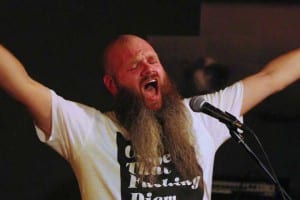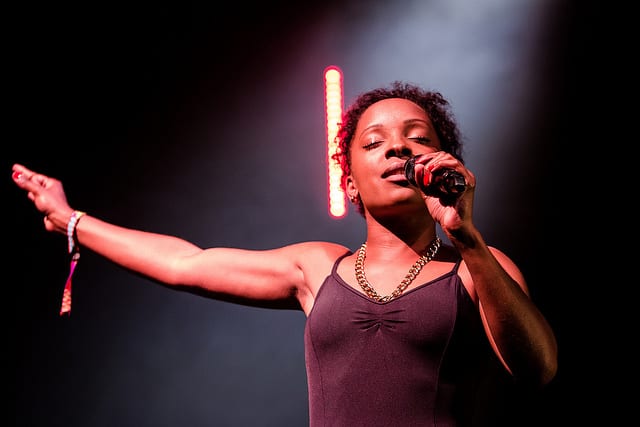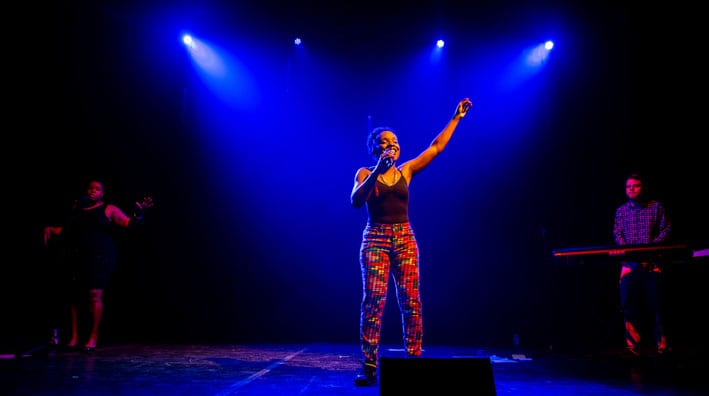Tag Archives: Music
Adam Page’s influence on my musical creation
When it came to creating this looped song, I thought it would have been much simpler than it actually turned out to be. When faced with learning how to use this loop pedal (something I’ve never used before), it was a daunting task, made even more daunting with the knowledge of a live audience. But over the last couple of days I’ve turned to my most influential solo performer for some guidance, Adam Page. During the beginning of this process a lot of my work was influenced by Laurie Anderson, which subsequently allowed me to form the basis of my show. However, as my ideas and concepts have developed, I have found my work steering away from the constant avant-garde musical underscoring of Laurie Anderson and more onto narrative and musical storytelling artists such as Adam Page.
I watched numerous of his performances, and gathered performance acting techniques, as well as musical techniques.
What I’ve learn from Adam
He is a great storyteller. He structures many of his shows around a single event or story, tells that story, then improvises a song about it. I would like to use this structure within my performance. To use the song as a commentary on my situation and story, rather than the song as the main focus like in much of Laurie Anderson’s work.
All of his musical work is completely improvised. This therefore makes the performance seem raw and slightly rugged. I really like this and think this honesty could be quite endearing in my performance. As the performances are all improvised, the objects he chooses to make music from are randomly picked from the objects around him. I like this a lot, and although my objects will be pre-chosen, I will perform it as though they are spontaneous decisions. I think doing this will be more in keeping with the relaxed, chilled out atmosphere, rather than being structured and pre-planned (which is completely contrasting to my cocoon).
My attempt at looping
Below is an example of one of many first attempts at looping. It was not as complex as I wanted the final song to be, but it was one of many stepping-stones towards the final piece.
After many days of experimenting with sounds and rhythms, below is a recording of the final song. Also, if the worst happens and it all goes wrong in the performance (as is often with live music), this is proof of what it should have sounded like!
With a little bit of luck
On Thursday 21st April I watched With a little bit of luck (2016), a Paines Plough production, written by Sabrina Mahfouz. Not only was the show a treat to watch, but it was also extremely influential for my own solo performance. Through spoken word, song, and poetry, it told the story of a 19 year girl, Nadia, who’s passion for UK garage music takes her into a spiral of bad decisions.
Immersive theatre
The ‘fist-pumping euphoria […] [and] diamond-clear language’ (Pringle, 2015) transported us, the audience, into a hypnotic trance-like place, where music and energy surged through your body, leaving it virtually impossible to not dance along. It was set in the Platform, with alcoholic drinks served from the bar, and dance music playing as soon as you stepped foot through the door. It felt more like a festival gig rather than a theatrical performance. One review commented that it offered ‘an ambient trip to the recent past […]. The mingling of live music, retro call backs and creative scripting are a fun, immersive combination’ (Fountain, 2016). I really liked how it immersed the audience into the themes of the performance from the outset, even from before the performance had started.
George Home-Cook stated that immersive theatre ‘claims to break down […] the audience/stage divide, and to invite the audience to actively participate in the theatrical event. Immersive theatre thus not only promises, but trades on it’s ability to provide a particular […] all-encompassing, multi-sensory, participatory experience’ (Home-Cook, 2015, 132). This made me think about my own performance and how I could create this intimacy and immediacy into my work. Was there any way of starting the performance (via the atmosphere) before I spoke a word? I thought back to my emphasis on my cocoons and their slow paced, homely feel.
Influenced by the works of Sabrina Mahfouz, I have decided to transform the far half of studio two into one giant stylised cocoon. The audience will walk through the door to be greeted by a dimly lit studio two. The far section will be curtained off and the audience will enter this section through a small parting in the curtains. This is my cocoon. Within this section the staging will be just as before, with the projector, music equipment and family memorabilia. I wish to create more of a relaxing atmosphere when the audience arrives to represent the comfort and relaxed way of life of my cocoons. The audience will be sat on beanbags, there will be smooth jazz playing in the background and incense sticks burning. I will be sat on stage in my pjs, having a cup of tea and reading a copy of The Stage Magazine. There is not one morning in my house that my mum and dad won’t have incense burning and jazz playing in the background; therefore I wanted to recreate this for the audience. Continuing on this idea of comfort, I will perform my entire performance in my pjs. The pjs show how I haven’t got dressed and ready to face the day, and how I’m still in my comfort zone. This draws parallels with my current situation, as I feel I have yet to get ready and face the real world, and how I’m still attached to my home relationships. When the performance is coming to an end, and I am creating music, the lights will gain brightness and by the end of the performance the audience will exit the cocoon to a brightly lit studio to, symbolising the brightly lit future now they have exited the comforting cocoons.
Speech underscored by music
What I also took from this performance was the use of music throughout the entire show. There was not one moment that was not accompanied by live musical underscoring. This stood out for me as I wanted to also underscore the last section of dialogue with the music I had made. This also reminded me of my earlier research on Laurie Anderson. Much of her work consists of spoken words underscored constantly by electronic music. For example, her most famous track Oh Superman! (1982). This unusual track seemed to hit a chord with the public at the time and rocketed to number one. The success of Laurie Anderson and With a little bit of luck, therefore, suggests that underscoring can be an effective theatrical tool. Both performances show me ways of playing with the volume and timing of the underscoring track in order to effectively interweave it into the pace of the dialogue. This is something I will be playing around with more over the next week.
Work Cited
Fountain, T. (2016) With a little bit of luck. [online] TV Bomb. Available from http://www.tvbomb.co.uk/2016/04/with-a-little-bit-of-luck/ [Accessed 26 April 2016].
Home-Cook, G. (2015) Theatre and Aural Attention: Stretching Ourselves. London: Palgrave Macmillan.
Mahfouz, S. (2016) With a little bit of luck. [performance] Stef O’Driscoll (dir.) Lincoln: Lincoln Performing Arts Centre, 21 April.
Pringle, S. (2015) Latitude 2015. [online] London: The Stage. Available from https://www.thestage.co.uk/reviews/2015/latitude-2015/ [Accessed 26 April 2016].
My day of experimenting
I’ve begun to play around with the musical side of my performance. I felt that the script and the themes were forming nicely so I began to experiment with the loop box and making rhythm and music from everyday objects. Below is a short video of my day.
Adam Page & Stomp
Adam Page
Musician and solo artist Adam Page has provided me with an abundance of ideas for my show. He is an Australian solo performer that specialises in music looping. He performed at the Edinburgh Fringe in 2013 and it was that performance which drew my attention to him. He is an insanely talented guy who can not only make music out of the most random and bazar objects, but he can also hold the audience’s attention throughout.
(Adam Page, 2013)
The following performance shows his ability to create music out of everyday objects that were lying around, including a sweet potato. I really like the idea of using lots of items and it has influenced me to slightly alter my performance. I originally wanted to make music only from the restraints themselves. Although after watching Adam Page use a multitude of objects to create a layered soundscape, I realised this would create more depth.
(Adam Page, 2012)
Whilst watching how he uses different object it made me realised that I could use objects that remind me of my relationship with my parents, sister and boyfriend. I would have them laid out around the tv screen to create three separate areas of objects that represent the three people I speak about. This would allow the music I create to represent the whole of my relationship with them rather than only the negative restraints. I want to portray how much these relationships mean to me and portray them in a good light, rather than portraying them as a burden as that is not how I see them.
Stomp
After researching Adam Page, it reminded me of Luke Cresswell and Steve McNicholas’ show Stomp (1991). I have always loved this show and I jumped at the chance to incorporate something similar within my own performance. The whole show consists of the actors creating beats and music out of everyday objects such as bins, sinks, brooms, newspapers etcetera. After watching both Adam Page and Stomp I have been experimenting with beats and sounds from everyday objects in my house, for example, photo albums, mugs, letters, pens etcetera. I hope that with the involvement of a loop box, I could create a detailed soundscape similar to theirs.
(Show & Stay, 2013)
Work Cited
Adam Page (2012) Adam Page Solo in Wellington 2009 – Kumerwah. [online video] Available from https://www.youtube.com/watch?v=pkRTj6YeqLY [Accessed 25 March 2016].
Adam Page (2013) ADAM PAGE at the Edinburgh Fringe FULL SHOW. [online video] Available from http://youtu.be/ivZQFIGwX4E [Accessed 25 March 2016].
Show & Stay (2013) Stomp Show Trailer. [online video] Available from https://www.youtube.com/watch?v=4-KDj0AHymU [Accessed 25 March 2016].




